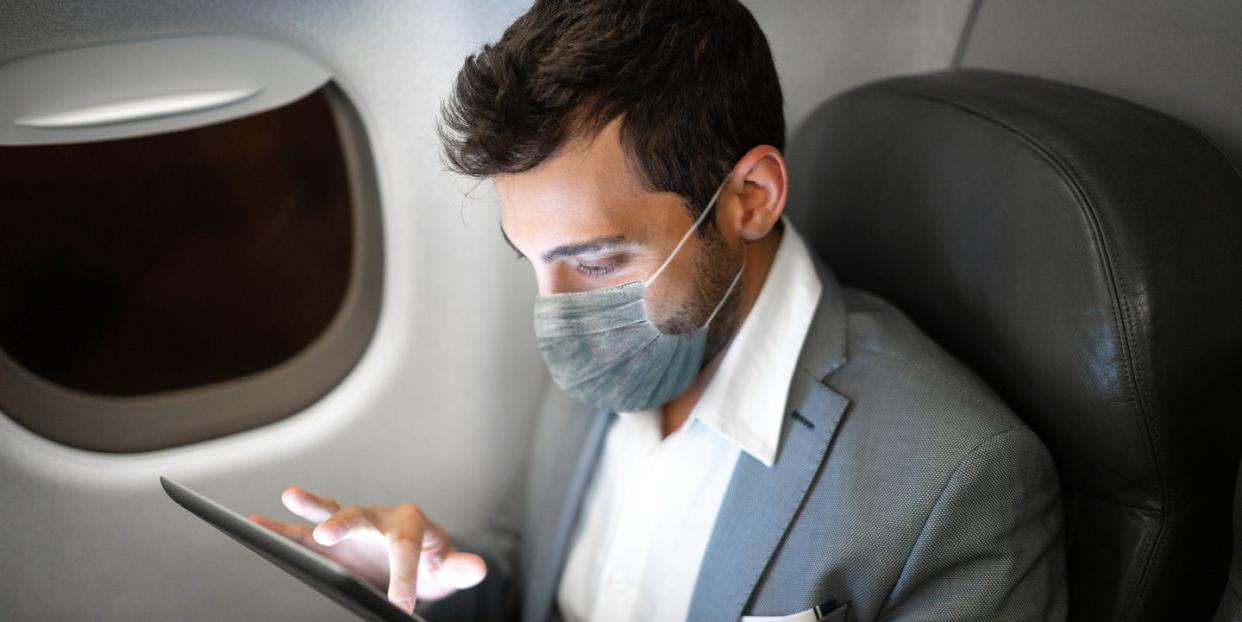7 Tips for Avoiding Coronavirus While Flying and Driving

Mike Hansen, MD is a critical care and pulmonary medicine specialist who makes YouTube videos explaining what medical professionals do and don't know with regards to the COVID-19 pandemic. In his most recent video, Hansen offered his professional advice for flying and driving safely now that travel restrictions have been loosened post-lockdown.
"In brief, this virus spreads by all three routes," he says. "It spreads by contact, it spreads by respiratory droplets that act like ballistics, and it spreads by the airborne route, meaning that very tiny droplets or aerosols remain suspended in the air, which then can be inhaled by someone else."
Hansen explains that a number of factors do lower the risk of contracting the virus on a plane. For instance, the air on most commercial flights is very clean, as compressed air is passed through the engines at extremely high temperatures, then cooled and put under high pressure. The air in a cabin is also exchanged every four minutes, which is faster than your average home or office air conditioner.
"If the virus is in the air, about 95 percent of it will be filtered out by these filters on the plane," says Hansen, "and the same thing goes for respirator masks. For the virus that remains in the air that does not exist within respiratory droplets, we still don't know if that virus is able to maintain infectivity because it may be dried out and inactivated in the process."
While the majority of people are following the public guidelines of washing their hands, not touching their faces, and maintaining a distance of 6 feet or more from other people, and most airlines require passengers to wear a face covering, Hansen says this may not be enough when traveling, especially in an enclosed environment like an airplane. "A face mask is not going to stop you inhaling that virus if it is in the air close to you," he says. However, wearing a mask will prevent the spread of those respiratory droplets if you happen to be asymptomatic and cough or sneeze during your flight.
Hansen says there are seven things you can do to maximize your safety, although he doesn't necessarily advise all of them.
Wear an N95 respirator mask. "These filter out at least 95 percent of airborne particles as small as 0.3 microns." However, the CDC currently doesn't allow them to be purchased by the public as they are being used by medical staff during the pandemic. Additionally, they require a test fitting to ensure they fit as tightly as possible, and cannot be worn by anyone with facial hair. An alternative, says Hansen, is an elastomeric respirator; a reusable device which uses cartridge filters.
Wear goggles. In addition to breathing in respiratory droplets, people can also get infected when air is blown into their eyes.
Turn on the overhead jets to circulate air. "Stagnant air is the enemy here," says Hansen. "Stagnant air makes it easier for the virus to linger. Not only that, but those overhead jets will actually push the air downward towards the floor, making it less likely to infect you."
Avoid people. Taking the redeye or a super early flight can be one way to minimize your contact with other people, as can purchasing a business class ticket (although this isn't exactly affordable for most people).
Avoid long flights. The amount of time you spend with someone who has the virus is a risk factor, and the longer you spend on a flight with other people, the greater your potential for infection.
Bring your own hand sanitizer. "You're going to be getting your hands dirty a lot, those respiratory droplets land on everything," says Hansen, "so anytime you touch anything there's the potential to get the virus on your hands. And of course, don't touch your face with your hands if they're not clean."
Bring sanitizing wipes. If you're going to use the drop-down tray at any point, you're going to want to be extra safe.
If the thought of flying is still too stressful, you might want to make your journey by car instead. In which case, Hansen advises taking the usual precautions throughout the trip.
"When you take a break from driving, you're going to want to wear the mask, wash your hands and all that other stuff," he says. "But the more people in the car, the higher the likelihood of someone spreading the virus if someone does have it. So for multiple people in the car, better for people to wear masks, and definitely crack open a window or two. If that virus is aerosolized, it will just fly out the window."
You Might Also Like
